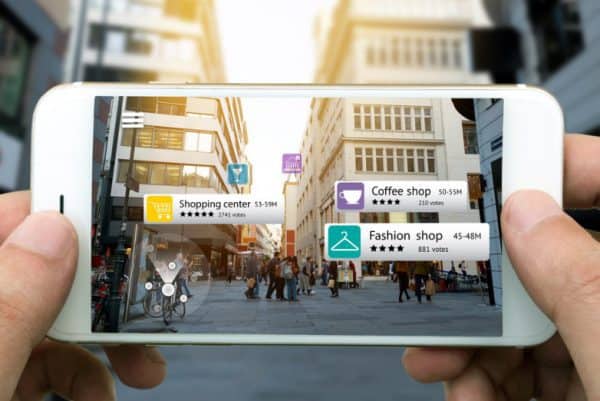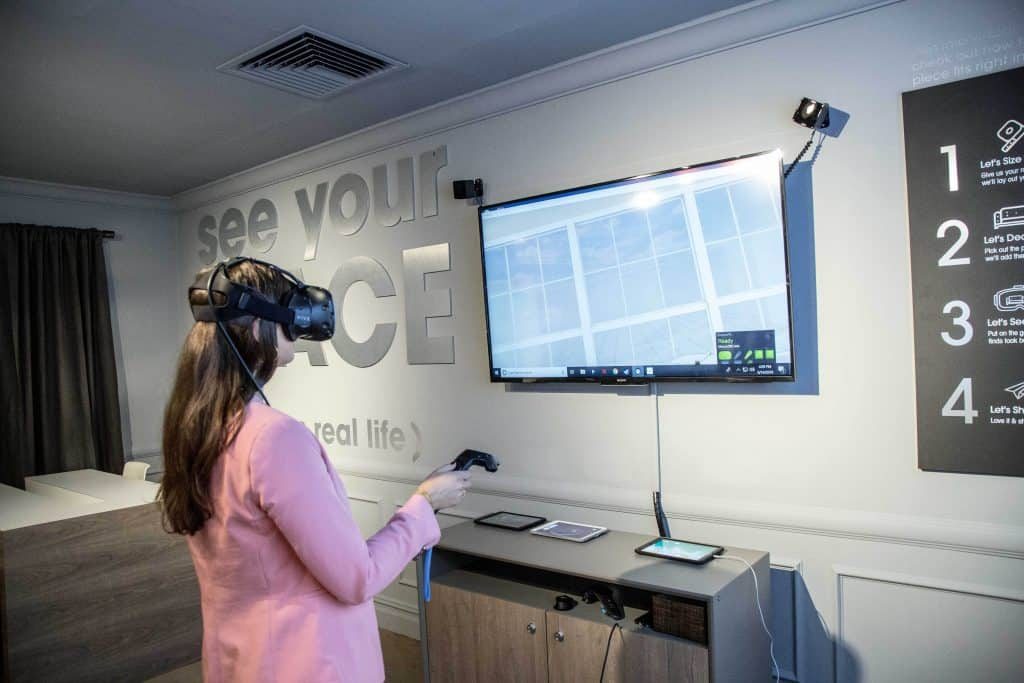VIRTUAL RETAIL – THE FUTURE IS NOW

No one alive today can deny the impact of technology, revolutionizing our world and transforming retail faster than you can say “Augmented Reality.” As retailers and brands continue to invest, MR offers our comprehensive guide to some of the amazing new technology available to enhance the shopping experience, increase sales and create customer loyalty. (Part 2 will appear online tomorrow.)
What’s in store for in-store?
The digital revolution that once threatened brick and mortar has backtracked a bit: shopping in-store remains essential but in an entirely different way. Today’s generation is more interested in experiences than objects; physical retail is one of many stops along an increasingly technological shopping spree. This is not news: many of you have already integrated the immediacy of online shopping with the personal experience of offline, giving way to ‘click and mortar’ or ‘clicks and bricks’. What seemed state-of-the-art is now simplistic: technology can unify multi-channel operations to offer a more seamless and integrated experience known as omnichannel.
Until now, multi-channel platforms have been experienced as silos that do not share information or work together – think of shoes that don’t go with the jacket, or the tie that clashes with the shirt. Not only is omni channel the stylist that brings it all together, but that tie can now help select an assortment of shirts and those shoes can walk you through a virtual store, gathering data instead of dust. Today’s consumers do not see brands in silos; they expect all the various touch points to work together. Marketers must captivate consumers across channels, or lose them to competition that is better at engagement.
Digitally native brands like Allbirds and Amazon–even Google–are boosting their previously web-based business models–with buildings. Whether to improve fulfillment, create community, build loyalty or enhance customer service, the newest technology allows retailers to maximize business from everywhere your customers buy–including your store. Consumers are now demanding an innovative reboot with a reimagined in-store encounter. Brick & mortar is on the rise as long as retailers find creative ways to keep customers coming back. Innovation and technology are the facilitators for retail’s new buzzwords: “Experiential” and “Personalization.”
The Experience...
Whileexperiential shopping delivers authenticity through gathering places (offering everything from haircuts to Hornitos), concept and pop-up shops keep things fresh with curated merchandise that invites a return. Artificial Intelligence (AI) has emerged to ‘one up’ the in-store experience and minimize returns. This technology that allows computers to make autonomous decisions is changing retail. Under the AI umbrella, Augmented Reality is working to track, enhance and personalize one’s version of the real physical world using visual elements, sound and other sensory stimuli. This is particularly important within the luxury category, according to a 2018 study by McKinsey & Company that found that nearly 80% of luxury sales were “digitally influenced” and that high-end spending online is expected to more than triple to $87 billion by 2025. However, the overall market share of luxury ecommerce pales in comparison to offline sales because high-end brands struggle to translate the luxury in-store experience to the online world. Toward that end, many luxury fashion e-commerce brands are working all platforms; immersive AR technologies–many solution-based–are being applied in new ways across the entire shopping and service cycle—from marketing to post-sale:
- What’s up with apps?–Engaging consumers on a personal level while motivating them to buy, retail apps provide entertainment, instant gratification and allow brands to capture valuable data while assisting from a phone. Mobile apps are a critical part of the omnichannel strategy, especially if they personalize, track behavior and leverage the collected data within an overall marketing strategy. Some have predicted the number of available apps will top five million by the year 2020. Making use of the latest technology, many apps are introducing sophisticated solutions to fashion failings. From GAP, whose DressingRoom app invites customers to shop using a virtual 3-D mannequin that matches their body type, to Neiman Marcus’ SoLoMo app (social, local and mobile) that connects customers and sales associates to create unique “co-shopping” experiences. At NM, sensors track customers throughout the store while the app connects them to preferred sales associates or allows them to scan QR codes for more product info. Macy’s is looking to make waves with an app that offers a faster, more ‘rewarding’ experience with ‘scan & pay’. Nordstrom’s mobile app personalizes the customer experience by merging online and in-store, tracking social media for trending products and mining that data to promote product via in-store signage at 200+ locations. But that’s not all: as the info procured feeds the “Nordstrom Innovation Lab” at the Seattle flagship, data is mined from the app, Facebook, Pinterest, Twitter and loyalty cards to curate experiences for customers based on preferences and in-store activity. All of the above move us closer to ensuring that inventory and experience match demand.

The Sampler app by Converse invites browsers to position their foot in front of cameras, scale a shoe to fit and then share on social media. And let’s not forget the gamers (often premium consumers and influencers) who thrive on value-added experiences like 3-D animations and 360-degree videos they cannot find anywhere else. Moving forward, innovators of ‘location-based entertainment’ apps and geolocation technology (think Pokémon Go and SnapChat), who can host scavenger hunts, create personalized messages, discounts or photo filters for those in proximity, stand to win big.
- Beacons–Speaking of location-based technology, Beacons work with Bluetooth transmitters interpreted by smartphones, watches and tablets to connect with customers within radius. Track engagement, encourage a Facebook ‘check-in’, offer a ‘valid during this visit’ discount, all while gaining insight into behavior.
- Digital Display–Intuitive and gaining in popularity for storefront and in-store, screens are engaging and interactive, building awareness and driving conversion. Kiosks provide an opportunity to upsell with intuitive technology and an Endless Aisle with touchscreens that access additional inventory or confirm dropship of an item that is temporarily sold-out–so nothing is ever out of stock.
- RFID–Primarily used for inventory management and to connect devices in the form of tags and interactive screens such as smart mirrors, RFID uses radio waves to identify and track items. The technology can provide valuable data about your shoppers and their real-time interactions, so you can be the first to know. Whether your clients buy online or in person, RFID facilitates a streamlined and positive customer experience.
- Interactive Mirror and Fitting Room–New technology elevates this area of activity by cross-selling, assisting and advertising. With the swipe of a finger, a garment appears in a “magic mirror” that overlays the customer’s image, offers fashion advice and gathers data for follow-through promotion. When your customer tries on that plaid Peter Millar sportcoat, an interactive screen can detect and interact to suggest several Eton shirts that make it pop. Sizing is accurate, and the technology can be modified for web and mobile. A former ‘pinch point’ now functions as PR as customers can snap and post photos from a touch screen.
- 3-D Body Scanner–You don’t have to be Superman to step into a tiny space and come out with a new set of duds. The 3-D body scanner is now assisting style associates at Alton Lane showrooms by acquiring measurements at the press of a button. After a scotch and fabric selection, the customer disrobes and walks into a bespoke booth lined with lights, sensors, scanners and a piece of interpreting software. Intentionally far from the ordinary, the nine-year-old custom menswear brand has designed what they call the “anti-retail store,” tailoring clothes as well as experiences. Together with human input, this 3-D output is sent to design and production teams offsite; the custom designs are delivered to the customer’s door within three to six weeks. The super human benefits: precision, consistent measurement and profile data that is readily accessible. Seen as a tool to help but not replace the human touch, the 3-D scanner can only do so much. Only an associate can go beyond the analytics to learn about the person, his lifestyle, habits and posture patterns–resulting in both the “right fit” and a personal connection.
- Here a bot, there a bot–Siri, Alexa and similar digital divas have become celebrities of voice recognition. Otherwise known as chatbots, the AI-enabled programs imitate human speech at home and in-store to provide directions and answer inquiries. Bots are already in use improving customer service and responding to retail challenges in toy-like fashion. “Pepper”, a Japanese silicone humanoid manufactured by Softbank Robotics, has coin-dot eyes, articulated limbs–-and more emotional intelligence than your average toddler. During last year’s holiday season, Pepper was employed at the Mall of America, welcoming shoppers and sharing information. Justine Santa Cruz, VP at Satisfi Labs and one of the collaborators behind MOA’s Pepper bot, validates, “By adding artificial intelligence to the customer experience, retailers learn about what their customers are actually thinking. Think of it as having a search bar on your entire store.” Pepper also hung out at the hip LA apparel store the Ave, contributing to a 98% increase in customer interactions, a 20% increase in foot traffic and a 300% increase in revenue. Nike and American Eagle are getting a bot-boost by engaging younger shoppers with bots that stylize with additional choices and customize through conversational platforms with human-like charm. Chatbots help streamline the post-purchase shipping process, answering questions about tracking and delivery. With no coffee break needed, they provide instantaneous responses around the clock.

Simulated Sales are Substantive
The newest wave of innovation beaming shoppers beyond their physical limits is Virtual Reality (VR). Similar and often intertwined with Augmented Reality, VR is a more immersive extension that pushes the imaginary envelope. No longer science fiction, this technology finds us buying real goods in imaginary settings–based on reality. Unlike Augmented Reality that requires interaction with reality and projects an overlay of virtual onto the physical world, Virtual Reality places the audience directly into the story, literally surrounding them with an up-close, 3-D, 360-degree view. Virtual reality can enhance a brand story and create emotion with a first-hand experience that draws an audience into the brand narrative as well as the environment. Using customized headsets, cameras and glasses, creative content places viewers right in the middle of scenes with freedom to look around as if they were there. It’s projected that customers and retailers alike will prefer virtual reality as a better in-store and online experience. While it’s not yet widely used, for some it’s already very real. IKEA is one of the first retail companies to launch a well-executed VR app–the IKEA VR Experience, that incorporates e-commerce into the experience of an IKEA virtual reality store. Can’t sleep? Grab your paisley fleece robe, HTC Vive headset, and a snack to wander the aisles of IKEA from your couch. The app allows you to explore several designed kitchens from different perspectives and angles. See the layout, change the color, even slam the drawers (you won’t wake anyone)–and upgrade your kitchen by morning.
Macy’s VR-influenced innovation has furniture sales increasing overall basket size by more than 60%. The retailer is working with a cloud-based tech service that allows head-set wearing shoppers to design a living space with 3-D furniture images and test it by virtually “entering” the room. Another bottom-line benefit–selling additional inventory that is warehoused elsewhere saves expensive real estate. As of press time, intrigued shoppers have access to headsets in 70 stores and Macy’s anticipates the technology in 20 more doors by 2019. In addition to increased sales, significant decreases in returns are helping the bottom line. The technology is based on the imaginary, but the margins are very real.








